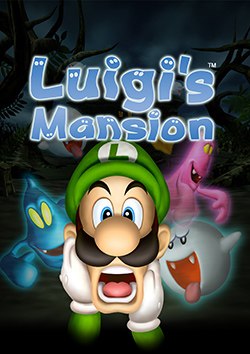Luigi's Mansion
| Luigi's Mansion | |
|---|---|
 |
|
| Developer(s) | Nintendo EAD |
| Publisher(s) | Nintendo |
| Director(s) | Hideki Konno |
| Producer(s) |
Shigeru Miyamoto Takashi Tezuka |
| Composer(s) |
Kazumi Totaka Shinobu Tanaka |
| Series | Luigi |
| Platform(s) | GameCube |
| Release | |
| Genre(s) | Action-adventure, Horror |
| Mode(s) | Single-player |
| Aggregate scores | |
|---|---|
| Aggregator | Score |
| GameRankings | 79.18% |
| Metacritic | 78/100 |
| Review scores | |
| Publication | Score |
| AllGame | |
| Edge | 8/10 |
| Famitsu | 34/40 |
| Game Informer | 9/10 |
| GameSpot | 7.9/10 |
| IGN | 7/10 |
| Nintendo Power | 4/5 |
Luigi's Mansion (Japanese: ルイージマンション Hepburn: Ruīji Manshon?, lit. Luigi Mansion) is a 2001 action-adventure game developed and published by Nintendo for the GameCube. The game was a launch title for the GameCube and is the first game in the Mario franchise to be released for the console, launched in Japan on September 14, 2001, in North America on November 18, 2001, and in Europe on May 3, 2002. It is the second title in the franchise in which Luigi is the main character, instead of Mario, with players controlling him as he explores a haunted mansion, dealing with ghosts that lie within its room by capturing them through a special device supplied by Elvin Gadd, a scientist in the Mario Universe who is introduced in this game, while searching for his missing brother.
Luigi's Mansion was relatively well received by reviewers, despite being criticized for its short length. The game has sold over 2.5 million copies, and is the fifth best-selling Nintendo GameCube game in the United States. It was one of the first games to be re-released as a Player's Choice title on the system. The game was later followed by a sequel entitled Luigi's Mansion: Dark Moon, released for the Nintendo 3DS in 2013.
In Luigi's Mansion, the main story is played out over four stages, with players able to also access a training room and a gallery at the laboratory of Professor E. Gadd between stages. In each stage, players control Luigi as he explores the mansion's rooms and hunts down the ghosts that lay within them, acquiring keys to get through locked doors and eventually dealing with a boss ghost hidden at the end of the stage, with more rooms becoming accessible as each stage is completed. To assist him in his task, Luigi uses a flashlight and two inventions supplied by E. Gadd - the Poltergust 3000, a specially modified, high powered vacuum cleaner; and the Game Boy Horror, a parody of Nintendo's Game Boy Color.
...
Wikipedia
